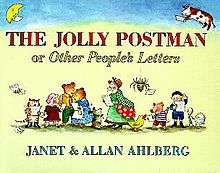The Jolly Postman
 Front cover of unknown edition | |
| Author | Janet and Allan Ahlberg |
|---|---|
| Illustrator | Janet Ahlberg |
| Cover artist | Janet Ahlberg |
| Country | United Kingdom |
| Language | English |
| Series | The Jolly Postman |
| Genre | Children's picture book, verse short story |
| Publisher | Heinemann |
Publication date | 1986 |
| Media type | Print (hardcover movable) |
| Pages | 48 pages, envelopes, and enclosures |
| ISBN | 0-434-92515-2 |
| OCLC | 59229153 |
| LC Class | PZ8.3.A278 Jo 1986[1] |
| Followed by | The Jolly Pocket Postman |
The Jolly Postman or Other People's Letters is an interactive children's picture book by Janet and Allan Ahlberg. The innovative project required five years to complete, and much discussion with both the publisher Heinemann and the printer before it was issued in 1986. The first subject heading assigned by WorldCat is "Toy and movable books". Little, Brown published a U.S. edition in the same year.
The Jolly Postman has sold more than six million copies, Allan Ahlberg told The Guardian in 2006. It made innovative use of envelopes to include letters, cards, games and a tiny book.[2]
Alternatively, The Jolly Postman is a series of three books including 1991 and 1995 sequels to The Jolly Postman, or Other people's letters. In the U.K., the first book won the Children's Book Award and the Kurt Maschler Award.[3][4] The second book won the 1991 Greenaway Medal for British children's book illustration.[5]
Summary
The Jolly Postman follows an unnamed mail carrier as he delivers letters by bicycle to characters from traditional children's stories that are well known in Britain. Following each sheet of narrative verse and illustration, there is one shaped like an envelope and containing one of the postman's deliveries. Each envelope is opened and its enclosure read at that point in the story.
WorldCat gives the entire description: "A Jolly Postman delivers letters to several famous fairy-tale characters such as the Big Bad Wolf, Cinderella, and the Three Bears. Twelve of the pages have been made into six envelopes and contain eight letters and cards. Each letter may be removed from its envelope page and read separately."[6][lower-alpha 1]
Awards
The Ahlbergs won two major British book awards for The Jolly Postman, the 1986 Kurt Maschler Award[4] and 1987 Children's Book Award. From 1982 to 1999 the "Emil" figurines from Maschler publishers and Booktrust annually recognised the creator(s) of one "work of imagination for children, in which text and illustration are integrated so that each enhances and balances the other".[4] The Federation of Children's Book Groups award (now named for the bookseller Red House) "celebrate[s] the books that children themselves love reading". The winner is determined by vote of British children.[3]
Janet Ahlberg was a commended runner up for the 1986 Greenaway Medal[7][lower-alpha 2] and she won the 1991 Greenaway for the sequel.[5] The annual award by the Library Association then recognised the year's best children's book illustration by a British subject.
Series
Following The Jolly Postman's success, the Ahlbergs and Heinemann produced two sequels. The latter, third in the series, was published after Janet's death in 1994. For the second book, The Jolly Christmas Postman, she won her second Kate Greenaway Medal.[5]
- "A Jolly Postman delivers letters to several famous fairy-tale characters such as the Big Bad Wolf, Cinderella, and the Three Bears. Twelve of the pages have been made into six envelopes and contain eight letters and cards. Each letter may be removed from its envelope page and read separately."[6]
- The Jolly Christmas Postman (1991, U.K. ISBN 0-434-92532-2)
- "A Jolly Postman delivers Christmas cards to several famous fairy-tale characters such as the Big Bad Wolf, Cinderella, and the Three Bears. Each card may be removed from its envelope page and read separately. With 6 letters in pockets".[9][10][11][12]
- "Join the jolly postman with his mailbag of delightful deliveries for Dorothy from Oz, Alice from Wonderland, and other favorite storybook characters."[15]
See also
Notes
- ↑ These are catalogue records from participating libraries, which vary even among copies of the same edition, and many provide no description or nothing useful.
- ↑ Today there are usually eight books on the Greenaway shortlist.
According to CCSU, some runners up through 2002 were Commended (from 1959) or Highly Commended (from 1974). There were 99 commendations of both kinds in 44 years including six in 1986.
No book series has won two Greenaway Medals. Chris Riddell was the highly commended runner up and the Medal winner, 1999 and 2001, for illustrating two books in the Diary series by Richard Platt. Graham Oakley was highly commended runner up in 1976 and 1982 for two books in his Church Mice series.
References
- 1 2 "The jolly postman, or, Other people's letters" (first U.S. edition). Library of Congress Catalog Record. Retrieved 2012-08-31.
- ↑ "Interview: Allan Ahlberg". The Guardian. 23 June 2006. Retrieved 2015-10-14.
- 1 2 "About the Red House Children's Book Award".
"Past Winners". Red House Children's Book Award (redhousechildrensbookaward.co.uk) . Retrieved 2015-10-14. - 1 2 3 "Kurt Maschler Awards". Book Awards. bizland.com. Retrieved 2012-07-19.
- 1 2 3 (Greenaway Winner 1991). Living Archive: Celebrating the Carnegie and Greenaway Winners. CILIP. Retrieved 2012-07-19.
- 1 2 "The jolly postman, or, Other people's letters" (one catalogue record for the first U.S. edition). WorldCat. Retrieved 2012-07-19.
- ↑ "Kate Greenaway Medal". 2007(?). Curriculum Lab. Elihu Burritt Library. Central Connecticut State University (CCSU). Retrieved 2012-07-19.
- ↑ WorldCat - one record for first U.S. edition
- ↑ ISBN 0434925322, oclc 26309381
- ↑ ISBN 0590471503, oclc 31616290
- ↑ ISBN oclc 614553556
- ↑ Little, Brown published a U.S. edition in October (next month)
- ↑ WorldCat
- ↑ U.S.
- ↑ "The jolly pocket postman" (first U.S. edition). Library of Congress Catalog Record. Retrieved 2012-08-31.
External links
- Toy and movable books Specimens subject class at WorldCat